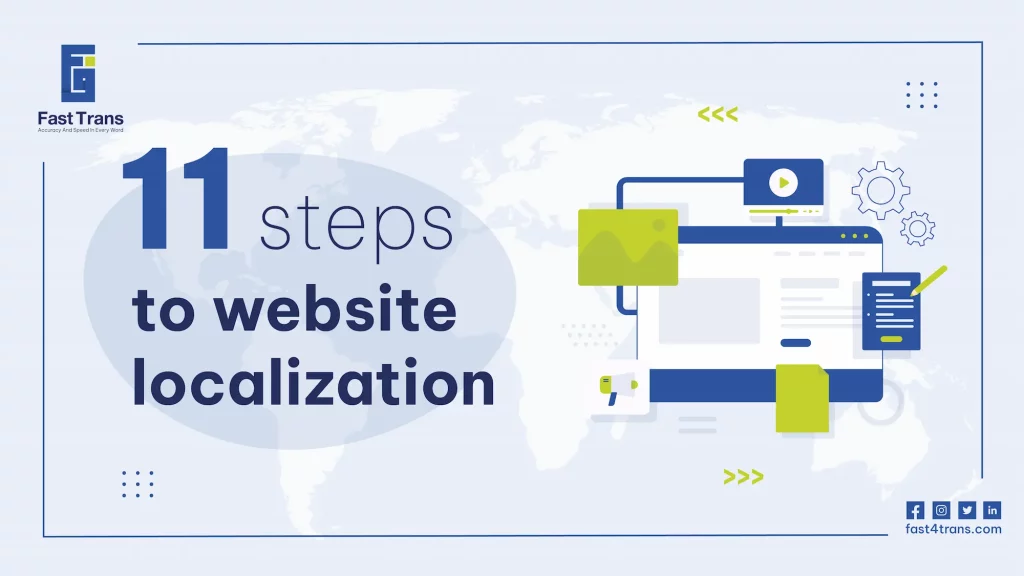Successfully Arabic Website Localization Steps involves strategic planning, cultural analysis, and a skilled team. It starts with a clear business plan, market research, and adapting content to local preferences, including keyword optimization and UX design that suits Arabic reading habits.
Internationalizing the website ensures it’s flexible for various Arabic regions, while automation and translation management systems streamline the process for consistency. Testing with native speakers helps identify issues, and promoting the site through local channels ensures it engages the target audience effectively.
Arabic Website Localization Steps
Arabic website localization involves strategic planning, market analysis, and the formation of a skilled team to ensure cultural relevance and technical precision. Key steps include keyword adaptation, automating the process, testing, and promoting the site for Arabic-speaking audiences while considering cultural nuances and user experience.
1. Website localization implementation strategy:
Preparing a business plan for Arabic website localization is a crucial task in this process. Without a clear, precise business plan, your localization effort may not meet expectations. It’s important to plan carefully to avoid missing fundamental steps required for an effective localization.
The strategy should outline each step, estimate the time, resources, and goals, and identify who will handle each task in order to localize your website for Arabic-speaking audiences.
2-In-depth analysis of potential target markets:
For a successful Arabic website localization, you must analyze the Arabic-speaking markets in detail. This involves understanding the cultural aspects of your target audience and learning from similar projects that have succeeded in these markets.
Researching factors like the competitive landscape, pricing, and how services are offered to Arabic consumers will help you tailor your content accordingly.
Consider if there is a need to adjust your products or services to better align with local preferences and cultural norms in the Arabic market.
3. Establishing a team of professional experts:
Forming a team of skilled professionals is key to successfully localizing your website for Arabic speakers. You need experts who understand the nuances of both Arabic culture and the technical requirements of localization.
This team should include a project manager to oversee the vision, a technical programmer for website integration, a designer focused on cultural adaptation of the website’s visuals, and a translator familiar with both linguistic and cultural aspects of Arabic.
Read more: why should localize your digital marketing campaign
4. Preparing for Future Arabic Website Localization Phases:
When planning your Arabic website localization, it’s important to think ahead. Instead of localizing for different Arabic dialects or regions separately, consider a strategy that addresses multiple Arabic-speaking regions simultaneously.
This requires a forward-thinking approach and an understanding of the cultural and market dynamics of the Arabic-speaking world, while also preparing for future market expansions.
5.Keyword Research for Arabic Markets:
Keyword research is an essential part of Arabic website localization. It’s important to adapt keywords to Arabic-speaking audiences, taking into account cultural context and local preferences. Simply translating existing keywords may not be enough, as different regions may have different terms or phrasing.
Effective keyword research will help you target Arabic-speaking users and optimize your content for search engines in Arabic.
6. Automate the Arabic Website Localization Process:
Automating the Arabic website localization process is critical to ensure accuracy and efficiency. Manual translation can lead to errors and consume too much time. By automating the localization process, you reduce the chance of mistakes and save resources.
Automation ensures a smoother, more accurate translation and localization flow, while also increasing scalability for Arabic website versions.
Read more about: Arabic E-Learning Localization The Complete Guide
7. A well-chosen translation management system
A Translation Management System (TMS) plays a vital role in automating the Arabic website localization process. This system streamlines the translation process by managing content from one language to another, ensuring consistency.
With Arabic localization, the TMS should be capable of managing Arabic text, considering script direction and unique cultural nuances. It’s important to work with a professional translator who can optimize and manage the TMS to improve the accuracy and cultural relevance of translations.
8. Website internationalization before localization:
Before localizing a website for Arabic, it’s important to ensure that it’s internationally ready. Website internationalization allows the site to be easily adapted to any Arabic-speaking market without needing extensive technical revisions. This involves separating translatable content from the underlying code, making the website more flexible for future Arabic translations and adaptations.
9. User Experience Localization for Arabic Audiences:
The user experience (UX) must be adapted for Arabic-speaking users to ensure it aligns with cultural expectations. This includes modifying the user interface to suit the Arabic right-to-left reading flow and making design choices that reflect Arabic cultural aesthetics.
Additionally, it’s important to consider the internet speed and browsing habits specific to Arabic-speaking regions to ensure that the site is accessible and user-friendly.
10. Test the Website Before Launching in Arabic Markets:
Before launching your Arabic website, thorough testing is crucial. Check for technical issues related to Arabic script, layout adjustments, and functionality. You should test the website with native Arabic speakers to ensure it feels natural to them.
Feedback from local testers can help identify potential problems and allow for fine-tuning before the official launch.
Read more about: Arabic website localization testing
11. Promote Your Localized Arabic Website:
Once your Arabic website is live, effective marketing is essential to attract Arabic-speaking users. Learn from the success of similar Arabic websites and implement strategies that cater to the Arabic-speaking audience’s needs and behaviors.
Marketing your website in Arabic through local channels and platforms will ensure that you reach the intended target audience and drive engagement with your localized products or services.
Read more about: What is Arabic Product Localization Strategy and it’s Benefits
How does fast-trans help with website localization?
Fast-trans, a certified translation company, will help you localize your website. We understand that the steps we have just discussed are complex, and long, and require quite a bit of your time and energy. These tasks may also seem difficult to you because your entire attention is focused on your small project and business. Fast-trans has therefore decided to assist you with the localization of your website:
- Provide an efficient and professional team to handle the website localization process: Fast-trans Certified Translation will offer a coherent and extremely skilled team to handle the website localization process. Fast-trans is primarily a translation company, but it also hires specialist experts to handle all aspects of website localization.
- Respect the time frame for your website localization project: Our specialists are aware that one of the most crucial factors in determining the success or failure of your website localization project is respecting the deadline. As such, they take great care to stick to the deadline that you both agreed on.
Conclusion
To successfully localize a website for Arabic-speaking audiences, a clear strategy is essential. The Arabic Website Localization Steps begins with creating a business plan that outlines the goals, resources, and timeline for the project. It’s important to thoroughly analyze target markets, considering cultural factors and local consumer behavior to tailor content. Establishing a team of skilled professionals, including project managers, technical experts, designers, and translators, ensures the localization process runs smoothly. Preparation for future expansion across various Arabic-speaking regions and careful selection of keywords specific to Arabic audiences also play a critical role in optimizing the website for search engines.
Further steps involve internationalizing the website to make it adaptable to different Arabic markets, ensuring that it works efficiently and can be updated with minimal technical changes. User experience (UX) should be carefully localized, with attention to the right-to-left reading format and cultural preferences. Thorough testing with native speakers helps identify issues before the website goes live. Once launched, effective promotion through local channels and platforms ensures the site reaches its target audience, driving engagement with localized products and services. A robust translation management system and automation tools are key to maintaining consistency and accuracy throughout the localization process.











